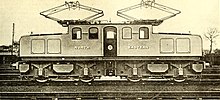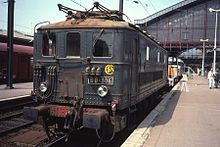Midi E 4200
| Midi E 4200 | |
|---|---|
|
E 4224 as BB 4224 of the SNCF in Gare de Lyon station in Paris (1992)
|
|
| Numbering: | E 4201–4250 ( Midi ) BB 4201–4250 ( SNCF ) |
| Number: | 50 |
| Manufacturer: | CEF |
| Year of construction (s): | 1934/35 |
| Retirement: | 1997 |
| Axis formula : | Bo'Bo ' |
| Gauge : | 1435 mm ( standard gauge ) |
| Length over buffers: | 12,870 mm |
| Service mass: | 80 t |
| Top speed: | 75 km / h |
| Continuous output : | 1160 kW |
| Number of traction motors: | 4 × type Altshom M1 |
| Drive: | electrical, 1500 V = |
The locomotives of the E 4200 series were standard gauge electric locomotives of the French railway company Compagnie des chemins de fer du Midi ( Midi ). They were almost identical to the 17 machines of the E 4700 series , they only differed from them in a different gear ratio. In 1938 they were taken over by the state railway SNCF founded that year under the same operating numbers .
prehistory
The Midi was the only one of the large French railway companies whose tracks did not lead to the capital Paris . Their stretches lay south of the Massif Central between the Atlantic and the Mediterranean and led far into the northern Pyrenees . Since the coalfields were far away in the north of France, the fuel for the operation of the steam locomotives had to be procured from other companies over long distances. Therefore, as early as 1909, an extensive electrification program was developed using the hydropower available in the Pyrenees .
A power supply by means of an overhead line with an alternating voltage of 12 kV and a frequency of 16 2⁄3 Hz was chosen. Between 1912 and 1914, electrical operation was started on four routes.
The extreme shortage of coal during the First World War - the main coalfields were occupied by German troops - prompted the government to decide to electrify additional railway lines. While those on the northern and eastern French routes were rejected for strategic military reasons, the electrification of railways in the southern half of France and in the greater Paris area with 1500 V DC was advocated . To standardize electrification in the country, the use of this voltage was made mandatory on August 29, 1920. This was to ensure that the locomotives could be used across networks in the event of another defense. The Midi then switched three of its already electrified routes to the prescribed electricity system.
Since no corresponding machines from local production had been developed, a group of Midi engineers looked around in Great Britain in 1918 . They found what they were looking for on the North Eastern Railway ; there were 10 four-axle bogie locomotives (later the EF 1 series ) with engines from Dick, Kerr & Co. , which they used as the basis for their own development. The Constructions électriques de France (CEF) company received the order to build 50 corresponding machines, Dick-Kerr himself supplied the plans and some of the motors. The series E 4000 (for freight trains) and E 4500 (for passenger traffic) only differed in the gear ratio. Unlike the British, the French locomotives but recognized - US -Konstruktionsprinzipien accordingly - a Boxcab - locomotive body with two Endführerständen on.
At the end of 1925 the electrified network of the Midi had exceeded the route length of 400 km. Suitable locomotives for freight transport had not yet been developed - the British engines had proven to be unsuitable for the topography of the Midi. Initially, a second series of the E 4000 was ordered, but the electrical part was fundamentally revised and delivered in 1926. Between 1928 and 1932, 140 locomotives of the series E 4100 (freight version) and E 4600 (for passenger trains) followed. 1932 merged the CEF with Alsthom , leading to the improvement of the robust and reliable traction motor led M1.
History and description
In 1930, the Midi ordered 67 locomotives from CEF , primarily for its Béziers – Neussargues (“Ligne des Causses”) and Montauban – Sète routes . The identical machines only differed in the gearbox. 50 locomotives of the E 4200 series (maximum speed 75 km / h) were intended for freight train service and 17 locomotives of the 90 km / h series E 4700 for passenger transport. They were built in the CEF factory in Tarbes and delivered in 1934/35.
The locomotives' boxes rest on two two-axle bogies. Frames and boxes are made of 10 mm thick sheet metal riveted to struts . The sheet metal of the bogies is 30 mm thick, and they are connected to one another via a movably mounted rod. The axle bearings are of the Isothermos type. Each axis is driven by an M1 type pivot bearing motor; these motors were jointly developed from the Dick Kerr DK107 motor from CEF and Alsthom. The M1 weighs 4100 kg and has a continuous output of 395 hp . It does not run hot and is very robust; a total of 1297 copies or descendants were built.
The TCP drive switch used for the first time in the E 4100 series enables three switching operations: series (all four motors one behind the other), series-parallel (the two motors of one bogie one behind the other) and parallel (one motor of one bogie with one of the second bogies one behind the other) . Strong blow magnets suppress the formation of arcs and enable the speed levels to be changed without interrupting the power supply. The compressors provide, inter alia, the compressed air for the lowering of the pantograph , the sliders are elastically mounted.
Due to the equipment of the substations of the Ligne des Causses with rotating mechanical rectifiers , recuperation brakes could be implemented for the first time in the predecessor series E 4100 . Alsthom perfected this brake for the successors E 4200 and E 4700, which in the series-parallel switching arrangement enabled electricity to be fed back into the contact line . The first timetables were designed so that locomotives traveling uphill received part of the traction energy they needed from machines moving downhill. If the system failed, the pneumatic brakes were automatically activated.
Initially, the E-4200 freight locomotives were stationed at the Tarbes depot , and by 1935 23 of them were relocated to Béziers . Its main area of use was the Bayonne – Sète and Bayonne – Bordeaux lines, and then also Montauban – Sète in 1935. On the steep sections of Bedous - Canfranc (the Pau - Canfranc railway ) and Ax-les-Thermes - Latour-de-Carol , they also carried passenger trains instead of the E 4700.
The SNCF included the locomotives in their numbering scheme after they were taken over in 1938. The E 4201-4250 became the BB 4201-4250, accordingly the E 4701-4717 were redrawn as BB 4701-4717. Between December 1953 and June 1954, the gear ratio was changed on some machines, which changed the series affiliation. This affected the BB 4244, 4236, 4230 and 4229, which became BB 4718 to 4721. From December 1973 to December 1975, the SNCF went the opposite way: In the Béziers depot , ten passenger locomotives of the 4700 series were converted into freight tractors (BB 4251–4260).
Around 1977 the substations of the Ligne des Causses were converted to silicon rectifiers . As a result, it was no longer possible to feed electricity back via regenerative braking, and the services on that route were taken over from the predecessor series BB 4100 (formerly E 4100). Between February 1975 and the end of 1979, 37 BB 4200 and 10 BB 4700 were converted into shunting locomotives and designated as the BB 4730 series. Among other things, the BB 4200 were exchanged for the gearboxes from the BB 4600 series (formerly E 4600), which in turn mutated into BB 4100 freight locomotives. Later another BB 4200 were assigned to the shift service; since they kept their gearbox, they were not redrawn as BB 4730.
Sister and successor series
The state-owned railway company Chemins de fer de l'État (ETAT), which operated rail traffic west of Paris, saved its own development and relied on the tried and tested E 4700 of the Midi. On this basis, Alsthom built 35 machines, which from 1936/37 ran at ETAT as the BB 100 series and were classified as BB 00 (901-935) at the SNCF.
The PO-Midi ordered machines derived from the E 4200 / E 4700 from CEF for its Tours – Bordeaux line . The E-241 to E-264 were delivered in 1938/39 and for the SNCF for the BB 300 series.
In 1946 the SNCF ordered another series of the BB 300 series. The BB 8100 series locomotives built between 1949 and 1952 are also descendants of the E 4200 / E 4700.
The Moroccan railway company Compagnie franco-espagnole du chemin de fer de Tanger à Fès (TF) received six corresponding machines (E-621 to E-627) in 1932.
Whereabouts
In 1997 the last locomotives of the series were parked. The BB 4240 was the only unmodified specimen that was preserved in Montgaillard in the Pyrenees in 2010 . In Tarascon-sur-Ariège the former BB 4202 existed as BB 4736, in Séméac the BB 4216 existed as BB 4732. Of the BB 4700 series, the BB 4701 (as BB 4769) was kept for the Cité du Train .
Individual evidence
- ^ Georges Mathieu: Le matériel moteur de la SNCF . 1st edition. Éditions La Vie du Rail, Paris 1992, ISBN 2-902808-48-8 , p. 24 f .
- ↑ Didier Janssoone: L'Histoire des chemins de fer pour les nuls , p. 64 ff.
- ↑ a b c d e f BB 900, BB 4200 & BB 4700. Des boîtes à ozone sous la loupe in: Ferrovissime No. 11., p. 33 ff.
- ↑ a b BB 900, BB 4200 & BB 4700. En ligne, en pousse et en maneuvers in: Ferrovissime No. 13., p. 33 ff.


